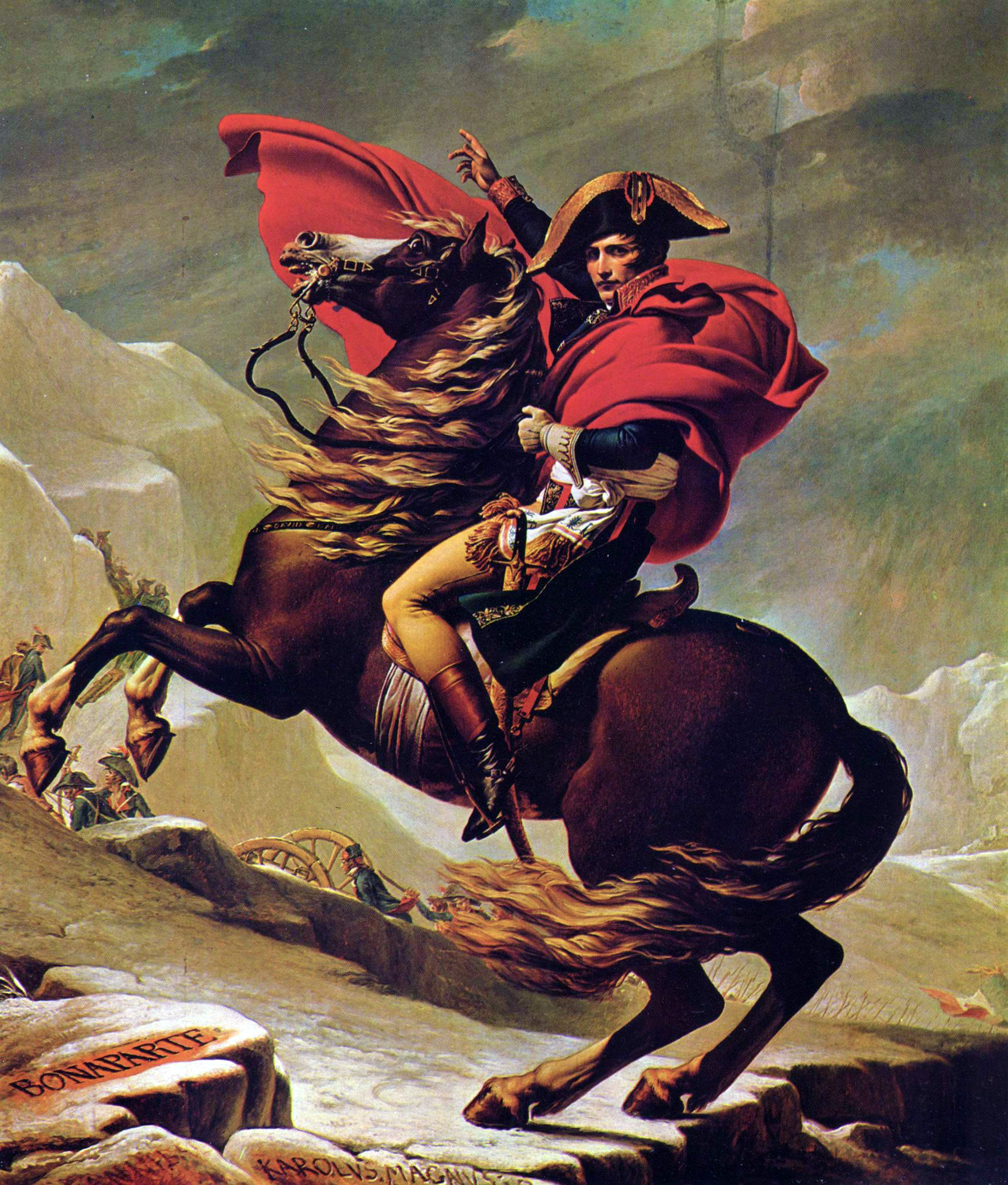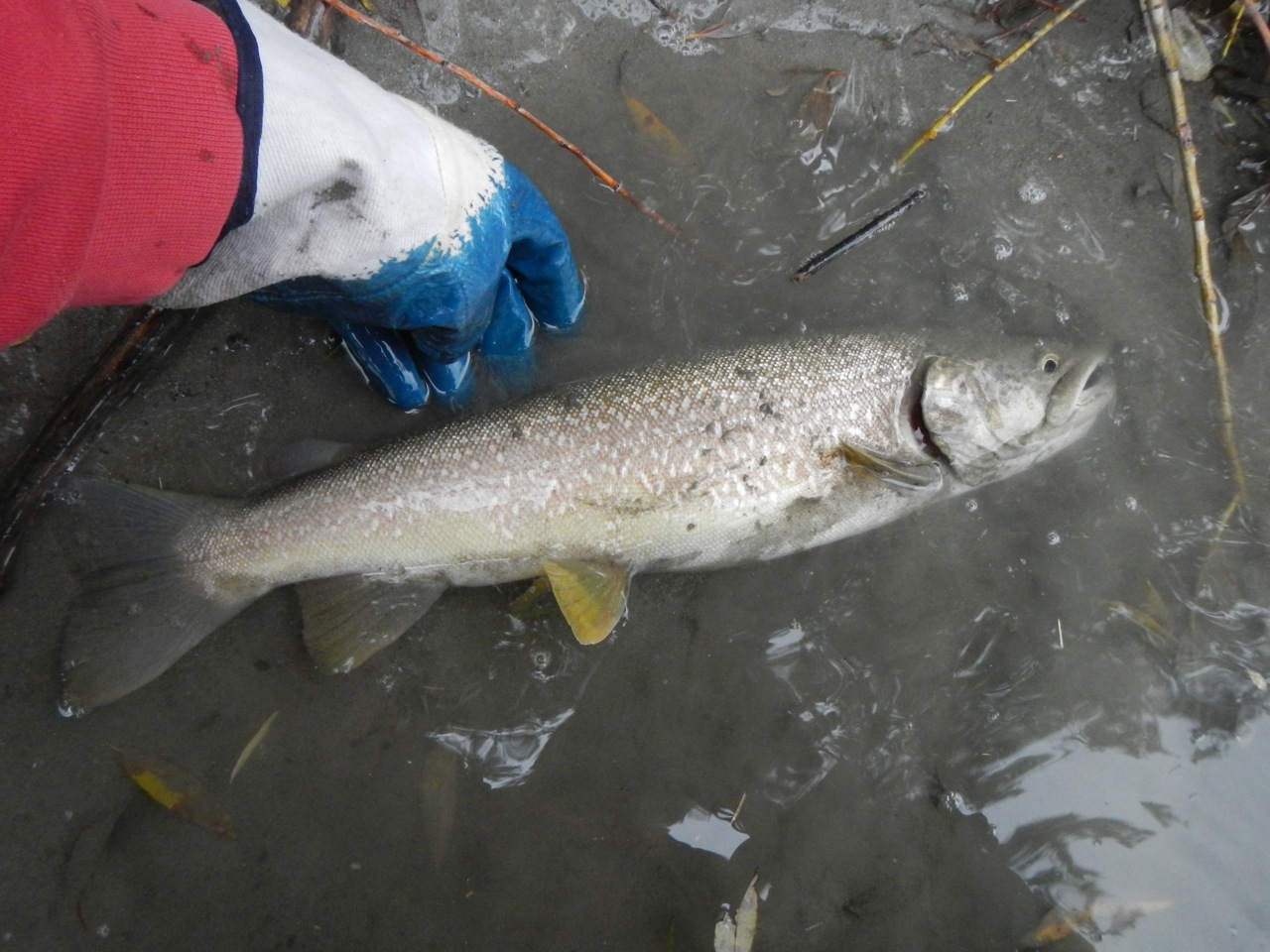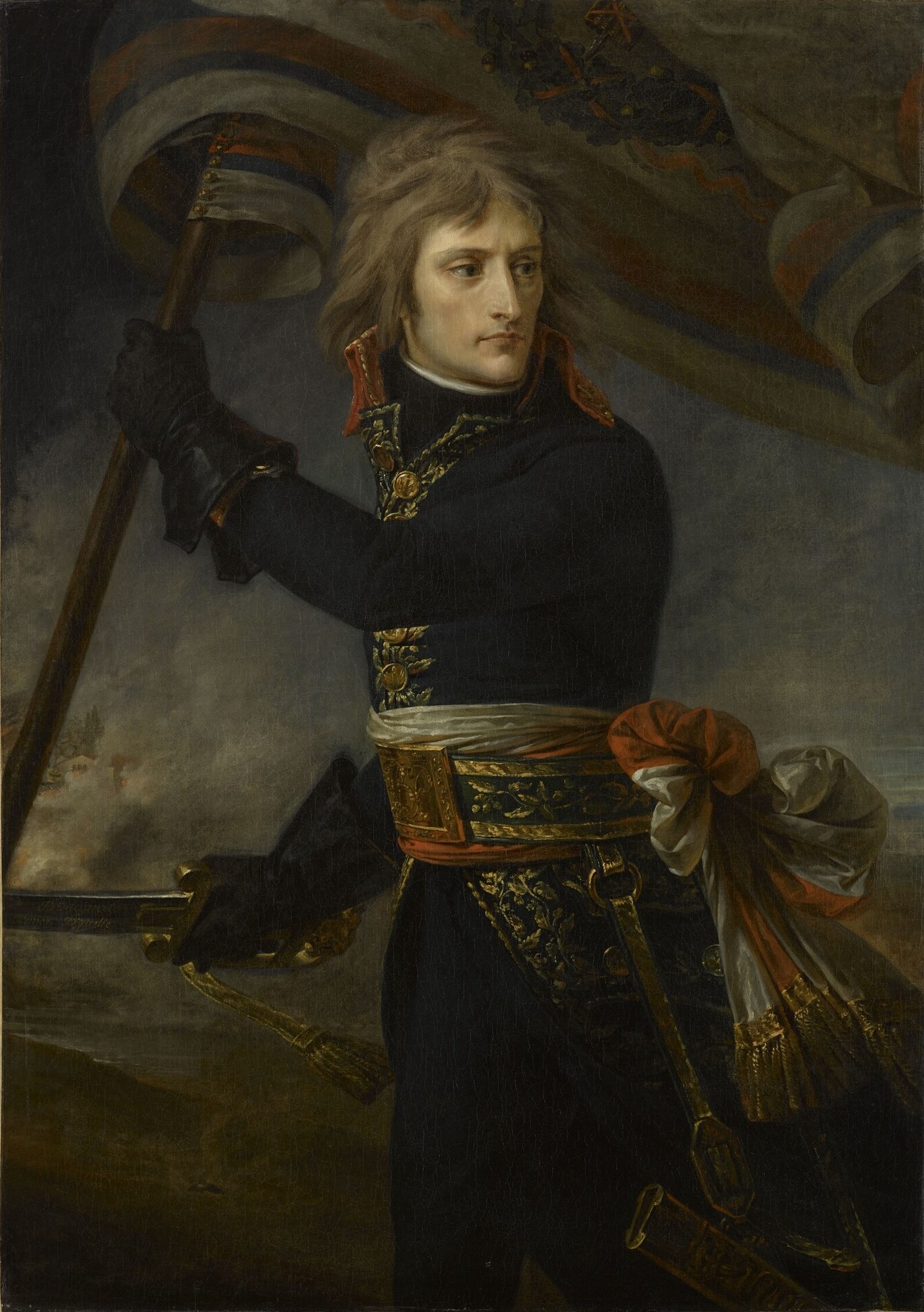|
Battle Of The Bridge Of Arcole
The Battle of Arcole or Battle of Arcola (15–17 November 1796) was fought between French and Austrian forces southeast of Verona during the War of the First Coalition, a part of the French Revolutionary Wars. The battle saw a bold maneuver by Napoleon Bonaparte's French Army of Italy to outflank the Austrian army led by József Alvinczi and cut off its line of retreat. The French victory proved to be a highly significant event during the third Austrian attempt to lift the siege of Mantua. Alvinczi planned to execute a two-pronged offensive against Bonaparte's army. The Austrian commander ordered Paul Davidovich to advance south along the Adige River valley with one corps while Alvinczi led the main army in an advance from the east. The Austrians hoped to raise the siege of Mantua where Dagobert Sigmund von Wurmser was trapped with a large garrison. If the two Austrian columns linked up and if Wurmser's troops were released, French prospects were grim. Davidovich scored a vi ... [...More Info...] [...Related Items...] OR: [Wikipedia] [Google] [Baidu] |
Italian Campaigns Of The French Revolutionary Wars
The Italian campaigns of the French Revolutionary Wars (1792–1802) were a series of conflicts fought principally in Northern Italy between the French Revolutionary Army and a Coalition of Austria, Russia, Piedmont-Sardinia, and a number of other Italian states. The campaign of 1796-1797 brought prominence to Napoleon Bonaparte, a young, largely unknown commander, who led French forces to victory over numerically superior Austrian and Sardinian Armies. First Coalition (1792–1797) The War of the First Coalition broke out in autumn 1792, when several European powers formed an alliance against Republican France. The first major operation was the annexation of the County of Nice and the Duchy of Savoy (both states of the Kingdom of Piedmont-Sardinia) by 30,000 French troops. This was reversed in mid-1793, when the Republican forces were withdrawn to deal with a revolt in Lyon, triggering a counter-invasion of Savoy by the Kingdom of Piedmont-Sardinia (a member of the First ... [...More Info...] [...Related Items...] OR: [Wikipedia] [Google] [Baidu] |
Battle Of Bassano
The Battle of Bassano was fought on 8 September 1796, during the French Revolutionary Wars, in the territory of the Republic of Venice, between a French army under Napoleon Bonaparte and Austrian forces led by Count Dagobert von Wurmser. The engagement occurred during the second Austrian attempt to raise the siege of Mantua. It was a French victory, however it was the last battle in Napoleon's perfect military career as two months later he would be defeated at the Second Battle of Bassano, ending his victorious streak. The Austrians abandoned their artillery and baggage, losing supplies, cannons, and battle standards to the French. Background Austrian plans The first relief of Mantua failed at the battles of Lonato and Castiglione in early August. The defeat caused Wurmser to retreat north up the Adige River valley. Meanwhile, the French reinvested the Austrian garrison of Mantua. Ordered by Emperor Francis II to relieve Mantua at once, ''Feldmarschall'' Wurmser and his ne ... [...More Info...] [...Related Items...] OR: [Wikipedia] [Google] [Baidu] |
Mantua
Mantua ( ; it, Mantova ; Lombard language, Lombard and la, Mantua) is a city and ''comune'' in Lombardy, Italy, and capital of the Province of Mantua, province of the same name. In 2016, Mantua was designated as the Italian Capital of Culture. In 2017, it was named as the European Capital of Gastronomy, included in the Eastern Lombardy District (together with the cities of Bergamo, Brescia, and Cremona). In 2008, Mantua's ''centro storico'' (old town) and Sabbioneta were declared by UNESCO to be a World Heritage Site. Mantua's historic power and influence under the Gonzaga family has made it one of the main artistic, culture, cultural, and especially musical hubs of Northern Italy and the country as a whole. Having one of the most splendid courts of Europe of the fifteenth, sixteenth, and early seventeenth centuries. Mantua is noted for its significant role in the history of opera; the city is also known for its architectural treasures and artifacts, elegant palaces, and the m ... [...More Info...] [...Related Items...] OR: [Wikipedia] [Google] [Baidu] |
Adige
The Adige (; german: Etsch ; vec, Àdexe ; rm, Adisch ; lld, Adesc; la, Athesis; grc, Ἄθεσις, Áthesis, or , ''Átagis'') is the second-longest river in Italy, after the Po. It rises near the Reschen Pass in the Vinschgau in the province of South Tyrol, near the Italian border with Austria and Switzerland, and flows through most of northeastern Italy to the Adriatic Sea. The river's name is Celtic in origin, from the Proto-Celtic cel-x-proto, *yt-ese, label=none, "the water", cognate with the River Tees in England (anciently ''Athesis'', ''Teesa''). Description The river source is near the Reschen Pass () close to the borders with Austria and Switzerland above the Inn valley. It flows through the artificial alpine Lake Reschen. The lake is known for the church tower that marks the site of the former village of Alt Graun ("Old Graun"); it was evacuated and flooded in 1953 after the dam was finished. Near Glurns, the Rom river joins from the Swiss Val Müstair. ... [...More Info...] [...Related Items...] OR: [Wikipedia] [Google] [Baidu] |
Paul Davidovich
Baron Paul Davidovich or Pavle Davidović ( sr-cyr, Павле Давидовић) (1737, Buda – 18 February 1814, Komárom) became a general of the Austrian Empire and a Knight of the Military Order of Maria Theresa. He played a major role in the 1796 Italian campaign during the French Revolutionary Wars, leading corps-sized commands in the fighting against the French army led by Napoleon Bonaparte. He led troops during the Napoleonic Wars and was Proprietor (Inhaber) of an Austrian infantry regiment. Early career Born in Buda (Ofen) (in modern-day Budapest, Hungary) in 1737, Davidovich came from a Serb family which had immigrated to the Austrian Empire from the Ottoman Empire at the time of Emperor Leopold I. In 1757, Davidovich joined the Austrian army's ''Ferdinand Karl'' Infantry Regiment #2. He served during the Seven Years' War and rose in rank to Captain. In 1771, he received promotion to Major in ''d'Alton'' Infantry Regiment #19. He performed heroically under ... [...More Info...] [...Related Items...] OR: [Wikipedia] [Google] [Baidu] |
Siege Of Mantua (1796-1797) (Second Coalition, French defending)
{{Disambig ...
Siege of Mantua can refer to: * Siege of Mantua (1630) (War of the Mantuan Succession, French defending) * Siege of Mantua (1702) (War of the Spanish Succession, French defending) *Siege of Mantua (1796–97) (First Coalition, French besieging) *Siege of Mantua (1799) The siege of Mantua (1799) was a four-month effort by the Austrian army to regain a presence in northern Italy after being excluded from that region by Napoleon Bonaparte through the successful French siege of Mantua in 1797. In April 1799, t ... [...More Info...] [...Related Items...] OR: [Wikipedia] [Google] [Baidu] |
Army Of Italy (France)
The Army of Italy (french: Armée d'Italie) was a field army of the French Army stationed on the Italian border and used for operations in Italy itself. Though it existed in some form in the 16th century through to the present, it is best known for its role during the French Revolutionary Wars (in which it was one of the early commands of Napoleon Bonaparte, during his Italian campaign) and Napoleonic Wars. History Bonaparte's reforms Poorly supplied (uniforms and shoes were rare), and only getting reinforcements irregularly, the Army of Italy was sometimes reduced to looting to survive. When Bonaparte arrived (he took up command on 27 March 1796), indiscipline was rife. Chouan songs were sung by the troops, and a company of the Dauphin was formed. All the while improving the supply system as much as possible, Bonaparte also reestablished discipline. He condemned officers who had cried ''Vive le roi !'', (English: "Live the king!"), dismissed the 13th regiment of hussa ... [...More Info...] [...Related Items...] OR: [Wikipedia] [Google] [Baidu] |
French Revolutionary Wars
The French Revolutionary Wars (french: Guerres de la Révolution française) were a series of sweeping military conflicts lasting from 1792 until 1802 and resulting from the French Revolution. They pitted French First Republic, France against Kingdom of Great Britain, Britain, Habsburg monarchy, Austria, Kingdom of Prussia, Prussia, Russian Empire, Russia, and several other monarchies. They are divided in two periods: the War of the First Coalition (1792–97) and the War of the Second Coalition (1798–1802). Initially confined to Europe, the fighting gradually assumed a global dimension. After a decade of constant warfare and aggressive diplomacy, France had conquered territories in the Italian Peninsula, the Low Countries and the Rhineland in Europe and abandoned Louisiana (New France), Louisiana in North America. French success in these conflicts ensured the spread of revolutionary principles over much of Europe. As early as 1791, the other monarchies of Europe looked with ou ... [...More Info...] [...Related Items...] OR: [Wikipedia] [Google] [Baidu] |
Verona
Verona ( , ; vec, Verona or ) is a city on the Adige River in Veneto, Northern Italy, Italy, with 258,031 inhabitants. It is one of the seven provincial capitals of the region. It is the largest city Comune, municipality in the region and the second largest in northeastern Italy. The metropolitan area of Verona covers an area of and has a population of 714,310 inhabitants. It is one of the main tourist destinations in northern Italy because of its artistic heritage and several annual fairs and shows as well as the Opera, opera season in the Verona Arena, Arena, an ancient Ancient Rome, Roman Amphitheatre, amphitheater. Between the 13th and 14th century the city was ruled by the Scaliger, della Scala Family. Under the rule of the family, in particular of Cangrande I della Scala, the city experienced great prosperity, becoming rich and powerful and being surrounded by new walls. The Della Scala era is survived in numerous monuments around Verona. Two of William Shakespeare's ... [...More Info...] [...Related Items...] OR: [Wikipedia] [Google] [Baidu] |
Battle Of Tarvis (1797)
The Battle of Tarvis was fought during 21–23 March 1797 near present-day Tarvisio in far northeast Italy, about west-by-southwest of the three-border conjunction with Austria and Slovenia, and was the final battle before the end of the War of the First Coalition. In the battle, three divisions of a First French Republic army commanded by Napoleon Bonaparte attacked several columns of the retreating Habsburg Austrian army led by Archduke Charles, Duke of Teschen. In three days of confused fighting, French divisions directed by André Masséna, Jean Joseph Guieu, and Jean-Mathieu-Philibert Sérurier succeeded in blocking the Tarvis Pass and capturing 3,500 Austrians led by Adam Bajalics von Bajahaza. The engagement occurred during the War of the First Coalition, part of the French Revolutionary Wars. After Bonaparte's capture of the fortress of Mantua in early February 1797, he cleared his south flank by crushing the army of the Papal States. Reinforced with forces from the ... [...More Info...] [...Related Items...] OR: [Wikipedia] [Google] [Baidu] |
Battle Of Valvasone (1797)
The Battle of Valvasone (16 March 1797), also named Battle of Tagliamento, saw a First French Republic army led by Napoleon Bonaparte attack a Habsburg Austrian army led by Archduke Charles, Duke of Teschen. The Austrian army fought a rear guard A rearguard is a part of a military force that protects it from attack from the rear, either during an advance or withdrawal. The term can also be used to describe forces protecting lines, such as communication lines, behind an army. Even more ... action against the French vanguard led by Jean-Baptiste Bernadotte at the crossing of the Tagliamento River but was defeated and withdrew to the northeast. The French troops crossed the Tagliamento, river at Valvasone and the battle developed on the opposite bank, mainly between the little villages of Gradisca (now in the municipality of Sedegliano) and Goricizza (now in the municipality of Codroipo). The next days, a French division cut off and captured an Austrian column at Gradisca ... [...More Info...] [...Related Items...] OR: [Wikipedia] [Google] [Baidu] |
Siege Of Mantua (1796–1797)
During the siege of Mantua, which lasted from 4 July 1796 to 2 February 1797 with a short break, French forces under the overall command of Napoleon Bonaparte besieged and blockaded a large Austrian garrison at Mantua for many months until it surrendered. This eventual surrender, together with the heavy losses incurred during four unsuccessful relief attempts, led indirectly to the Austrians suing for peace in 1797. The siege occurred during the War of the First Coalition, which is part of the French Revolutionary Wars. Mantua, a city in the Lombardy region of Italy, lies on the Mincio River. After driving the Austrian army out of northwest and north-central Italy, the French invested the fortress of Mantua starting in early June 1796. In late July, a new Austrian commander, Dagobert Sigmund von Wurmser led an army to the relief of Josef Franz Canto d'Irles' garrison from the north. Mantua was reached and the French were forced to abandon the siege. However, the Austrians were su ... [...More Info...] [...Related Items...] OR: [Wikipedia] [Google] [Baidu] |





.jpg)